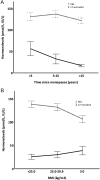Premature menopause and autoimmune primary ovarian insufficiency in two international multi-center cohorts
- PMID: 35521804
- PMCID: PMC9175594
- DOI: 10.1530/EC-22-0024
Premature menopause and autoimmune primary ovarian insufficiency in two international multi-center cohorts
Abstract
Objective: To investigate markers of premature menopause (<40 years) and specifically the prevalence of autoimmune primary ovarian insufficiency (POI) in European women.
Design: Postmenopausal women were categorized according to age at menopause and self-reported reason for menopause in a cross-sectional analysis of 6870 women.
Methods: Variables associated with the timing of menopause and hormone measurements of 17β-estradiol and follicle-stimulating hormone were explored using multivariable logistic regression analysis. Specific immunoprecipitating assays of steroidogenic autoantibodies against 21-hydroxylase (21-OH), side-chain cleavage enzyme (anti-SCC) and 17alpha-hydroxylase (17 OH), as well as NACHT leucine-rich-repeat protein 5 were used to identify women with likely autoimmune POI.
Results: Premature menopause was identified in 2.8% of women, and these women had higher frequencies of nulliparity (37.4% vs 19.7%), obesity (28.7% vs 21.4%), osteoporosis (17.1% vs 11.6%), hormone replacement therapy (59.1% vs 36.9%) and never smokers (60.1% vs 50.9%) (P < 0.05), compared to women with menopause ≥40 years. Iatrogenic causes were found in 91 (47%) and non-ovarian causes in 27 (14%) women, while 77 (39%) women were classified as POI of unknown cause, resulting in a 1.1% prevalence of idiopathic POI. After adjustments nulliparity was the only variable significantly associated with POI (odds ratio 2.46; 95% CI 1.63-3.42). Based on the presence of autoantibodies against 21 OH and SCC, 4.5% of POI cases were of likely autoimmune origin.
Conclusion: Idiopathic POI affects 1.1% of all women and almost half of the women with premature menopause. Autoimmunity explains 4.5% of these cases judged by positive steroidogenic autoantibodies.
Keywords: autoimmune; premature menopause; premature ovarian failure; premature ovarian insufficiency; primary ovarian insufficiency.
Figures






Similar articles
-
Primary Ovarian Insufficiency in Women With Addison's Disease.J Clin Endocrinol Metab. 2021 Jun 16;106(7):e2656-e2663. doi: 10.1210/clinem/dgab140. J Clin Endocrinol Metab. 2021. PMID: 33686417 Free PMC article.
-
Primary ovarian insufficiency due to steroidogenic cell autoimmunity is associated with a preserved pool of functioning follicles.J Clin Endocrinol Metab. 2009 Oct;94(10):3816-23. doi: 10.1210/jc.2009-0817. Epub 2009 Jul 21. J Clin Endocrinol Metab. 2009. PMID: 19622621
-
Steroid-cell autoantibodies are preferentially expressed in women with premature ovarian failure who have adrenal autoimmunity.Fertil Steril. 2002 Aug;78(2):270-9. doi: 10.1016/s0015-0282(02)03205-3. Fertil Steril. 2002. PMID: 12137862
-
Autoimmune primary ovarian insufficiency.Autoimmun Rev. 2014 Apr-May;13(4-5):427-30. doi: 10.1016/j.autrev.2014.01.003. Epub 2014 Jan 10. Autoimmun Rev. 2014. PMID: 24418305 Review.
-
Research Progress on the Etiology and Treatment of Premature Ovarian Insufficiency.Biomed Hub. 2023 Dec 13;8(1):97-107. doi: 10.1159/000535508. eCollection 2023 Jan-Dec. Biomed Hub. 2023. PMID: 38094192 Free PMC article. Review.
Cited by
-
Autoimmune Disease is Increased in Women With Primary Ovarian Insufficiency.J Clin Endocrinol Metab. 2025 Jul 15;110(8):e2614-e2620. doi: 10.1210/clinem/dgae828. J Clin Endocrinol Metab. 2025. PMID: 39607709 Free PMC article.
-
Improving diagnostic precision in primary ovarian insufficiency using comprehensive genetic and autoantibody testing.Hum Reprod. 2024 Jan 5;39(1):177-189. doi: 10.1093/humrep/dead233. Hum Reprod. 2024. PMID: 37953503 Free PMC article.
-
Primary ovarian insufficiency: update on clinical and genetic findings.Front Endocrinol (Lausanne). 2024 Sep 26;15:1464803. doi: 10.3389/fendo.2024.1464803. eCollection 2024. Front Endocrinol (Lausanne). 2024. PMID: 39391877 Free PMC article. Review.
-
Premature ovarian insufficiency.Nat Rev Dis Primers. 2024 Sep 12;10(1):63. doi: 10.1038/s41572-024-00547-5. Nat Rev Dis Primers. 2024. PMID: 39266563 Review.
-
Parsing Genetic and Autoimmune Etiology in Premature Ovarian Insufficiency.JCEM Case Rep. 2023 Dec 1;1(6):luad124. doi: 10.1210/jcemcr/luad124. eCollection 2023 Nov. JCEM Case Rep. 2023. PMID: 38045866 Free PMC article.
References
-
- Harlow SD, Gass M, Hall JE, Lobo R, Maki P, Rebar RW, Sherman S, Sluss PM, de Villiers TJ. & STRAW + 10 Collaborative Group. Executive summary of the stages of Reproductive Aging Workshop + 10: addressing the unfinished agenda of staging reproductive aging. Journal of Clinical Endocrinology and Metabolism 2012971159–1168. (10.1210/jc.2011-3362) - DOI - PMC - PubMed
-
- Triebner K, Markevych I, Hustad S, Benediktsdóttir B, Forsberg B, Franklin KA, Gullón Blanco JA, Holm M, Jaquemin B, Jarvis D, et al.Residential surrounding greenspace and age at menopause: a 20-year European study (ECRHS). Environment International 2019132105088. (10.1016/j.envint.2019.105088) - DOI - PubMed
-
- Dratva J, Gómez Real F, Schindler C, Ackermann-Liebrich U, Gerbase MW, Probst-Hensch NM, Svanes C, Omenaas ER, Neukirch F, Wjst Met al.Is age at menopause increasing across Europe? Results on age at menopause and determinants from two population-based studies. Menopause 200916385–394. (10.1097/gme.0b013e31818aefef) - DOI - PubMed
LinkOut - more resources
Full Text Sources
Research Materials

